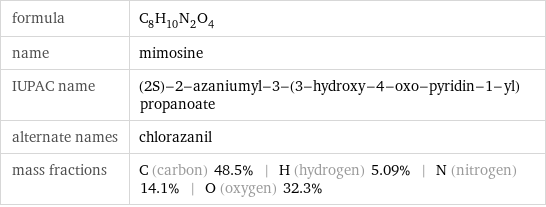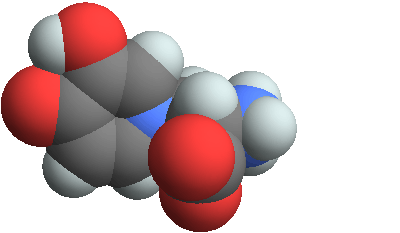Input interpretation

mimosine
Chemical names and formulas

formula | C_8H_10N_2O_4 name | mimosine IUPAC name | (2S)-2-azaniumyl-3-(3-hydroxy-4-oxo-pyridin-1-yl)propanoate alternate names | chlorazanil mass fractions | C (carbon) 48.5% | H (hydrogen) 5.09% | N (nitrogen) 14.1% | O (oxygen) 32.3%
Lewis structure

Draw the Lewis structure of mimosine. Start by drawing the overall structure of the molecule, ignoring potential double and triple bonds: Count the total valence electrons of the carbon (n_C, val = 4), hydrogen (n_H, val = 1), nitrogen (n_N, val = 5), and oxygen (n_O, val = 6) atoms: 8 n_C, val + 10 n_H, val + 2 n_N, val + 4 n_O, val = 76 Calculate the number of electrons needed to completely fill the valence shells for carbon (n_C, full = 8), hydrogen (n_H, full = 2), nitrogen (n_N, full = 8), and oxygen (n_O, full = 8): 8 n_C, full + 10 n_H, full + 2 n_N, full + 4 n_O, full = 132 Subtracting these two numbers shows that 132 - 76 = 56 bonding electrons are needed. Each bond has two electrons, so in addition to the 24 bonds already present in the diagram add 4 bonds. To minimize formal charge oxygen wants 2 bonds and carbon wants 4 bonds. Identify the atoms that want additional bonds and the number of electrons remaining on each atom: To fully fill its valence shell, nitrogen will donate one of its electrons, allowing it to form four bonds (atoms on period 2 cannot have an expanded valence shell). Fill in the 4 bonds by pairing electrons between adjacent highlighted atoms, noting the formal charges of the atoms. Double bonding carbon to the other highlighted oxygen atom would result in an equivalent molecule: Answer: | |
3D structure

3D structure
Basic properties

molar mass | 198.18 g/mol phase | solid (at STP) melting point | 237 °C solubility in water | very soluble
Units

Hydrophobicity and permeability properties

experimental LogP hydrophobicity | -2.5 predicted LogP hydrophobicity | -2.42 predicted LogS | -1.18
Basic drug properties

approval status | approved | small molecule drug categories | antineoplastic agent
Chemical identifiers
![CAS number | 500-44-7 Beilstein number | 86165 PubChem CID number | 6971294 PubChem SID number | 7336 SMILES identifier | C1=CN(C=C(C1=O)O)CC(C(=O)[O-])[NH3+] InChI identifier | InChI=1/C8H10N2O4/c9-5(8(13)14)3-10-2-1-6(11)7(12)4-10/h1-2, 4-5, 12H, 3, 9H2, (H, 13, 14)/t5-/m0/s1/f/h9H InChI key | WZNJWVWKTVETCG-ZUNUQWMWDH EU number | 207-905-1 NSC number | 69188](../image_source/8a777d9db767b3d8bba9bd87eb0fe84d.png)
CAS number | 500-44-7 Beilstein number | 86165 PubChem CID number | 6971294 PubChem SID number | 7336 SMILES identifier | C1=CN(C=C(C1=O)O)CC(C(=O)[O-])[NH3+] InChI identifier | InChI=1/C8H10N2O4/c9-5(8(13)14)3-10-2-1-6(11)7(12)4-10/h1-2, 4-5, 12H, 3, 9H2, (H, 13, 14)/t5-/m0/s1/f/h9H InChI key | WZNJWVWKTVETCG-ZUNUQWMWDH EU number | 207-905-1 NSC number | 69188